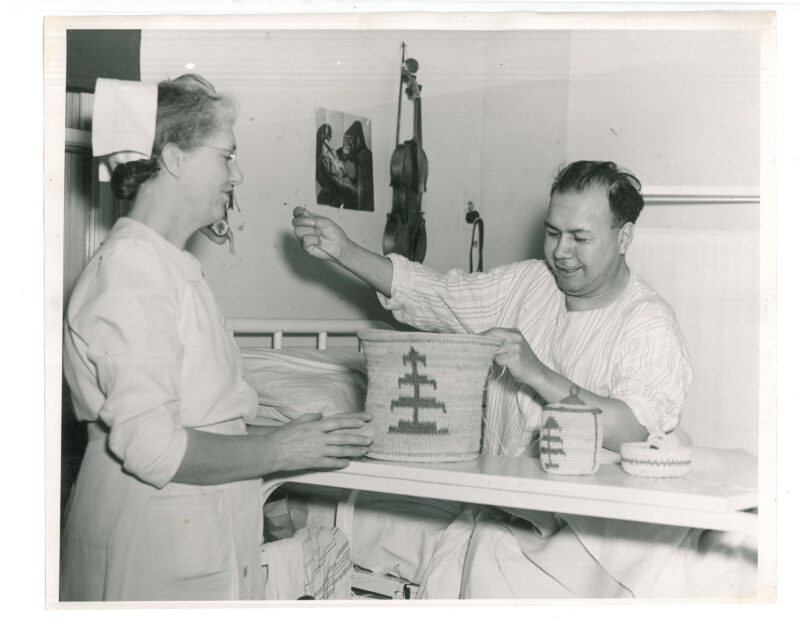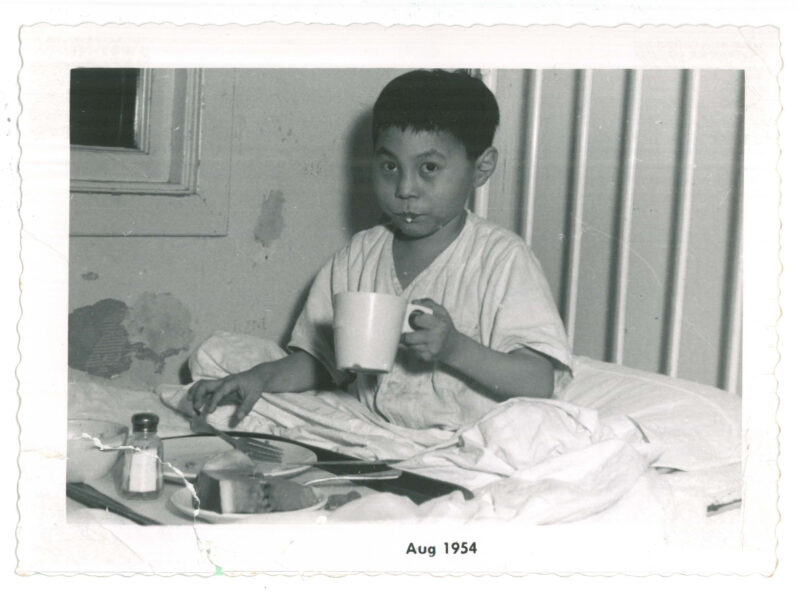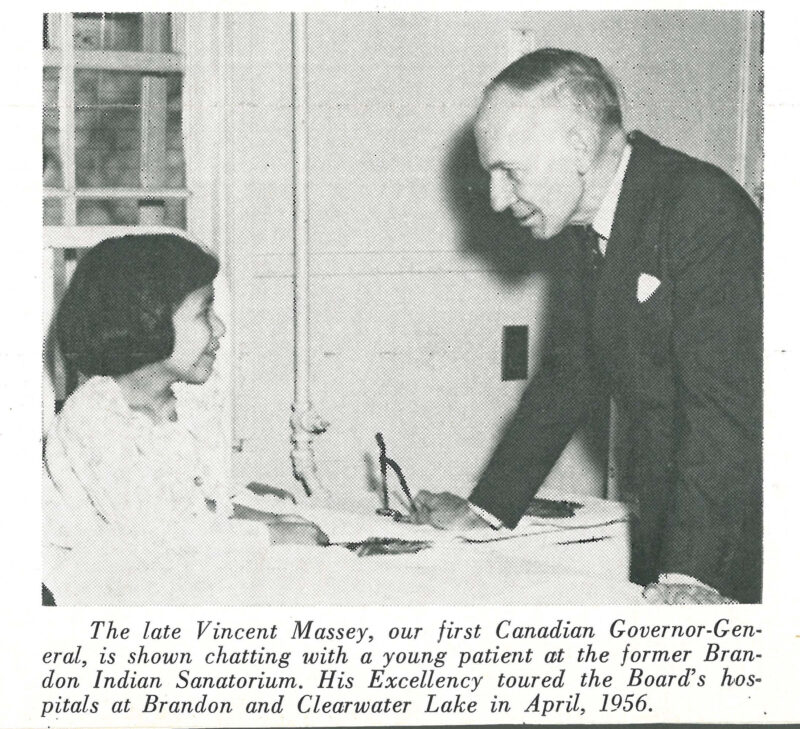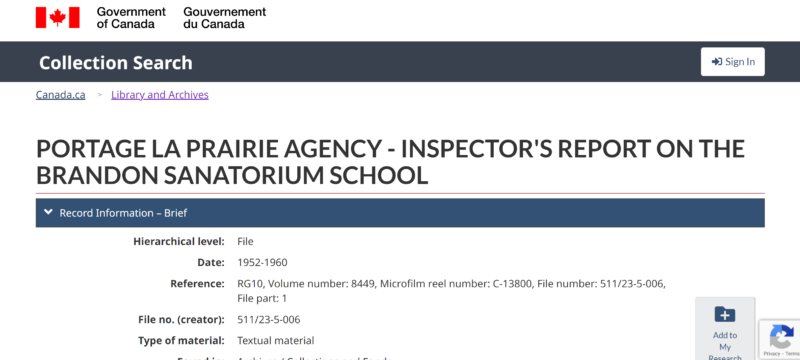Brandon Indian Sanatorium
This page will be updated periodically as our research into records related to patients treated at Brandon Indian Sanatorium continues.
The Brandon Indian Sanatorium (later the first Assiniboine Rehabilitation Hospital) opened its doors in 1947 in a converted military hospital at the corner of 10th Street and Queens Avenue in Brandon. The hospital, which was funded by the federal Indian Health Service and operated by the Sanatorium Board of Manitoba, initially treated primarily First Nations patients, but also some Métis and non-Indigenous patients as well. Soon after it opened, Inuit patients from the Central and Eastern Arctic began arriving at the sanatorium as well.
As with other Indian hospitals and sanatoriums in Manitoba, patients were sometimes moved into the Brandon Sanatorium or from the Brandon facility to another Indian hospital or sanatorium for specialized treatment, or for other reasons. Over time, as other facilities closed, patients were sometimes moved to Brandon, including the 20 patients who were transferred to the Brandon Sanatorium when the Dynevor Indian Hospital closed its doors in 1957.
In the late 1950s and early 1960s, the Brandon Sanatorium moved away from tuberculosis treatment as it was converted into a rehabilitation and long-term treatment facility and renamed the Assiniboine Hospital. Between 1958 and 1961, the remaining tuberculosis patients in Brandon were moved to the Ninette Sanatorium.
Where should I begin?
Before you begin your search, read our 'Where Do I Begin?' section of the website, including the Research Tips.
Depending on where your family or community member lived there are several “first stop” sources where researchers can begin. You may also find it helpful to come back to these sources if you have started somewhere else but hit a dead-end in your research.
Your research will take time. And maybe a lot of time, depending on how quickly various organizations respond your requests. Start the process of contacting them and requesting records as early as possible.
Before you contact the archives or records organizations, it is good to have some basic information handy, including:
- names, including any alternates (maiden names, stepparent names, nicknames, etc.)
- where you think the person died or where they might be buried
- general time frame, especially an idea of when they may have passed away
You can download a fillable pdf copy of our Research Checklist here.
This last piece of information is especially important for burial records, which sometimes contain personal health information (eg. the cause of death). In those cases, that record may be restricted, and you may have to wait a certain amount of time after a person’s death to access the records. In Manitoba, death records become unrestricted 70 years after death at which point some of the information becomes available in the Manitoba Vital Statistics online database. See the Manitoba Vital Statistics section below for additional information.

Raffia work by patient Alex Catcheway with nurse Mrs. Agnew, Brandon Indian Sanatorium, Manitoba Lung Association, MBLung 03-05-001
1. Records of the Sanatorium Board of Manitoba
The Sanatorium Board of Manitoba ran the Brandon Sanatorium from 1947 until it converted to the Assiniboine Hospital and ceased treating Indigenous TB patients between 1958 and 1961.
Most of the surviving records of the SBM are held by the Archives of Manitoba. Access to records that include information that may identify individual patients is restricted under the Manitoba Personal Health Information Act.
You can request that a search be performed in these restricted records, like the San Board Central Tuberculosis Register, to see if there is information about a specific patient. To request these records, fill out and submit a Personal Health Information (PHIA) request.
The PHIA request forms are not designed for historical record requests and the form may ask you to provide information or proof that is not available to you. That’s ok. Just fill in the information that you have and indicate how you are related to the patient in question. Please note that information requests for PHIA searches can only be made by the patient or a family member of the patient.
2. The Manitoba Vital Statistics Database
Many of the deaths that occurred at the Brandon Indian Sanatorium were recorded with Manitoba’s Vital Statistics Agency. If the death occurred more than 70 years ago, you can search for the person’s name in the Manitoba Vital Statistics online database. The database is updated every three months, so deaths that occurred between October and December of a year may not be added until sometime after January.
Using this database may be easier if you know a few tricks. You can also find an example of how the database can provide information related to burial sites in our Research Case Study: Manitoba Vital Statistics and Residential School Students.
Note: If you are looking for a family member who may have passed away less than 70 years ago, you can contact the Vital Statistics Agency and ask if you are able to request their death record. They may or may not be able to help in this situation, but you can ask.
3. The Nanilavut Initiative
Inuit patients were sent to the Brandon Indian Sanatorium beginning in the 1950s.
If you are searching for information about an Inuit patient from the Inuvialuit Settlement Region you can request information from The Nanilavut Initiative. The Nanilavut Initiative was established after the Qikiqtani Truth Commission to help Inuvialuit and Inuit from across Canada locate lost loved ones who did not return home after being sent to southern hospitals during the Tuberculosis Epidemic (1940s to 1960s).
News story: In Pursuit of Resolution: Families continue to grieve loved ones who died of tuberculosis in the south (Nunavut News/North, 2017)

This child is identified in images published in the Camsell Pictorial Review (1957) as an Inuk boy named Okatchuk. This photo from the Manitoba Lung Association collection is dated August 1954. Okatchuk left the Brandon Sanatorium with a group of Inuit returning to their home communities in September 1956. Manitoba Lung Association, MBLung 03-04-001
4. Government of the NWT: Medical Patient Search Project
If the person you are searching for came from the Northwest Territories, the Government of the Northwest Territories may be able to help you by searching records held by the NWT Archives.
During the last part of the twentieth century, the Government of the Northwest Territories launched a program to help families locate people who did not return following TB treatment. The NWT Government will attempt to help anyone whose family member was sent from the NWT to a southern hospital to locate information if they are able. Contact the NWT Archives here.
5. Manitoba Genealogical Society
The Manitoba Genealogical Society (MGS) has a wealth of cemetery transcriptions and knowledgeable volunteers. Some of their resources are available online for free, but the best access is provided through purchasing a membership for a small fee.
Members and non-members can search the online Manitoba Name Index (MANI). You may need to try various spellings in your searches. Because many of the patients who died were not memorialized in a published obituary or with a headstone, the online databases may not be as helpful as some of the transcriptions the MGS holds in their collections but that are not included in the online databases. Only members can access the records that appear in the MANI database.
There are regional MGS sites across the province. If you cannot find what you need online and/or cannot attend a regional site, you can hire a volunteer to help you search through the MGS.
6. Library and Archives Canada
We will be adding more information about what is available through Library and Archives Canada (LAC) in the coming months. Broadly, LAC's collections include school files that may be helpful if the person you are looking for was a student at a residential school or sometimes a student at school located in a TB hospital. LAC also holds records of tuberculosis surveys and some hospital admissions. For young people who entered a sanatorium, family allowance records may also be helpful in your search.
Health records, family allowance files, and some school records will be restricted, but you may be able to make a request to see a particular record or records relating to yourself or a person who has passed away. The formal request procedure is explained online here.

A patient at Brandon Indian Sanatorium speaks with Governor General Vincent Massey, April 1956, Manitoba Lung Association, MBLung 08-02-001
What sources can I consult that are specific to the Brandon Sanatorium?
Note from the MITHP Research Team: We have found evidence of patients from the Brandon Sanatorium being buried at Fisher River. We will update on these burials as we continue our research.
1. Brandon Municipal Cemetery
At the time of writing, we have identified burials relating to the Brandon Sanatorium at the Brandon Municipal Cemetery. This cemetery has an excellent online search tool that allows you to find the approximate location of graves, even those that are unmarked.
Most of these burials appear to date from 1947 to early in 1950, but there are also several names from the late 1950s who are probably patients.
2. St. Augustine of Canterbury Roman Catholic Church, Brandon
Records indicate that the funeral for at least one patient who passed away at the Brandon Sanatorium was performed at the St. Augustine Catholic Church in Brandon. It is possible that this church may have records of other patient deaths as well.
St. Augustine of Canterbury Roman Catholic Church
327-4th Street
Brandon Manitoba Canada R7A 3H1
Phone:
204.727.4728
Email: office@staug.ca
3. Sioux Valley/Oak River Cemetery at Sioux Valley Dakota Nation
If the patient passed away between 1950 and 1958, the person you are looking for may have been buried at Sioux Valley Dakota Nation (formerly known as the Oak River Reserve). If you have ordered a death record from Manitoba Vital Statistics and the record includes burial information, it may point you to this cemetery.
If the patient you are looking for was Inuit and from the Inuvialuit Settlement Region, contact the Nanilavut Initiative for assistance.
3A. List of Brandon Sanatorium Burials at Sioux Valley/Oak River Cemetery
Collaborative research by Sioux Valley Dakota Nation and MITHP researchers, led by Dr. Anne Lindsay, have identified approximately 50 burials to date in the area set aside for Brandon patients in the Anglican cemetery at Sioux Valley. We believe that the graves were initially marked with wooden crosses that included an engraved metal plate with the name of the deceased. Over time and due to a prairie fire that swept through the section of the cemetery that contains the Brandon Sanatorium burials, some of these grave markers are no longer standing or the name plates are missing.
The information contained in the document below is the result of ongoing research and this list may not be fully complete. We will provide updates when new information becomes available.
Sioux Valley Dakota Nation Cemetery Burials from Brandon Indian Sanatorium
If you are thinking of visiting SVDN, or would like to contact someone there about patient burials in the SVDN cemetery, you can contact SVDN’s Climate Change and Special Projects Coordinator:
Attn: Climate Change & Environment/Lands Department
PO Box 38
Griswold MB R0M 0S0
Monday - Friday: 8:30 - 4:30
Phone: 1-204-855-2671 Toll free: 1-866-721-0293
3B. Sioux Valley/Oak River Cemetery: Anglican Burials
The Anglican Diocese of Brandon holds the burial records for the Anglican burials at Sioux Valley/Oak River cemetery (St. Luke’s/Sioux Valley parish). These records also include a small number of non-Anglican patient names. You can request a search for a burial record by contacting the diocese:
Contact: Administrative Archivist Ms. Teresa Longworth
Telephone: (204) 727-2380, ext. 101
Email: info@brandon.anglican.ca
3C. Sioux Valley/Oak River Cemetery: Catholic Burials
The Catholic Church on the Sioux Valley/Oak River Reserve was originally established as an Oblate Mission overseen by Oblate missionaries at Lebret, Saskatchewan.
Because this church was served by Oblate missionaries from Saskatchewan, but also sometimes by local priests who travelled from local parishes, locating the Sacramental records for the Sioux Valley Catholic Church is difficult. Most likely, the sacramental registers for the Sioux Valley Catholic Church were destroyed when the church burned down.
There are other possible options. Burial records for individuals may be with Oblate Records from Lebret, Saskatchewan and the Lebret/Qu’Appelle Indian Residential School, which are housed with the Archdiocese of Regina.
For the years the church was served by a local priest, the records may be included in the records of the parish that priest was from. To find where these records might be, you will first need to find the home church of the person who served the church that year. It should be possible to find the “home parish” of the mission for a given year by using Le Canada Ecclesiastique. Scroll down the page to find the particular year you are interested in, then you can look up either: Oak River or (later) Griswold. Once you know where the priest for the year you are looking for was from, you can follow up either with the Regina Archdiocese Archives or with the particular parish the priest was from.
Note: As a general rule, Catholic burial records stay with the church that created the records. If that church closes the records may be sent to an archives, but often they are sent to a nearby church that has taken over responsibility for the closed church. It may take a little work to identify where records have been moved in cases like this.
MITHP researchers are continuing to research the location of the Catholic sacramental registers, and we will update this section as new information arises.
3D. Sioux Valley/Oak River Cemetery: Other Denominations
If the person you are looking for was not Anglican or Catholic, you may want to contact these archives:
Conference of Manitoba Northwestern Ontario & All Native Circle Conference
United Church of Canada Archives
Presbyterian Church in Canada Archives
4. Other Hospitals
Patients were transferred between TB hospitals, but they were also sometimes moved to other local hospitals. The Brandon Sanatorium was not equipped to handle labour and delivery, for instance, so babies may have been delivered at the Brandon General Hospital. Some patients may have passed away at the Brandon Mental Hospital. You may want to make a PHIA request (see section above) for patient records if you think that the person you are looking for might have died at one of these facilities.
If you are having trouble finding a patient you believe was a patient at the Brandon Indian Sanatorium, you may also want to try looking at Ninette Sanatorium, especially in the later years of Brandon’s operations as the hospital began to transition from a sanatorium to a rehabilitation hospital.
5. Federal Voters Lists for the Brandon Sanatorium/Assiniboine Hospital
The MITHP team has complied Federal Voters Lists for the Brandon Sanatorium/Assiniboine Hospital for select years from 1949 through the 1960s. Voters lists for provincial or municipal elections are not included here.
Brandon Indian Sanatorium Assiniboine Hospital Federal Voters lists
6. RG 10 Indian Hospital School Files
All three of the Manitoba Indian TB hospitals, the Ninette Sanatorium, and the St. Boniface Sanatorium had schools in the hospitals. At Brandon Indian Sanatorium, Dynevor Indian Hospital, and Clearwater Lake Indian Hospital the schools were federally funded and were inspected by federal authorities. They were subject to regular reporting, including pupil lists. Pupils were not always limited to young people and can include adult patient-students as well. The school inspection records are held in Library and Archives Canada (LAC) collections. Some of these records are open and available online, others must be requested through LAC via an Access to Information and Privacy (ATIP) Online Request. You can also contact LAC to help locate records that might be relevant but are not necessarily obvious from LAC database searches.
The archive of the National Center for Truth and Reconciliation Archive has some of the RG 10 school files available online, but the records are not complete. Some of the Admissions and Discharges files in particular are missing. The RG 10 school files are digitized via the LAC website here.
Heritage Canadiana is another resource for hospital school records. Heritage Canadiana is the online repository for some non-restricted files that LAC has digitized. To figure out if the file that you want to view is available online through Heritage Canadiana, follow these steps:
- Locate the file in the LAC online catalogue.
- Determine if the catalogue listing has a microfilm number. Note the volume and file number in the LAC online listing.
- Cross-reference that microfilm number by searching for it on Heritage Canadiana.
- Once you have located the reel on Heritage Canadiana, locate the volume that you are looking for (these are usually in numerical order on the microfilm). Once you are in the area of that volume number, look for the file number.
EXAMPLE
On the Library and Archives Canada website, perform a Collections Search for keywords relating to the topic you are searching for. In this case, we searched 'Brandon sanatorium school.'
This search brings up several search results, including PORTAGE LA PRAIRIE AGENCY - INSPECTOR'S REPORT ON THE BRANDON SANATORIUM SCHOOL .
The listing indicates that these documents can be found on LAC microfilm reel C-13880.

On Heritage Canadiana, Microfilm reel C-13880 can be found here.

The following are additional LAC files about the Brandon Indian Sanatorium school that may be useful to your search. Please note that these files focus more on staff and on the operation of the school. Library and Archives Canada may hold student lists for this school, but you may have to request them through an Access to Information request. See above general information about how to do this.
Date: 1947-1960 Reference: RG10. Volume/box number: 8608. File number: 511/1-13-006.
Textual material. [Conditions of access Open]. Government. File.
RG10, Volume number: 8608, Microfilm reel number: C-14230, C-14230, File number: 511/1-13-006, File part: 1
Heritage Canadiana link
PORTAGE LA PRAIRIE AGENCY - INSPECTOR'S REPORT ON THE BRANDON SANATORIUM SCHOOL
Date: 1952-1960
Reference: RG10. Volume/box number: 8449. File number: 511/23-5-006.
Textual material. [Conditions of access Open]. Government. File.
RG10, Volume number: 8449, Microfilm reel number: C-13800, C-13800, File number: 511/23-5-006
Heritage Canadiana link
Date: 1947-1964
Reference: RG10. Volume/box number: 7194. File number: 511/25-1-006.
Textual material. [Conditions of access Open]. Government. File.
RG10, Volume number: 7194, Microfilm reel number: C-9700, C-9700, File number: 511/25-1-006
Heritage Canadiana link

